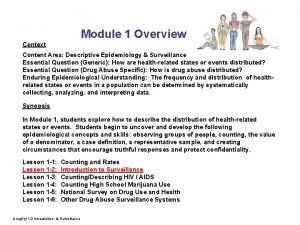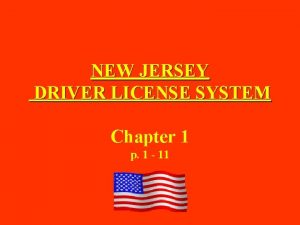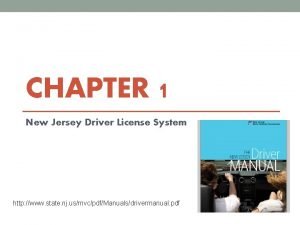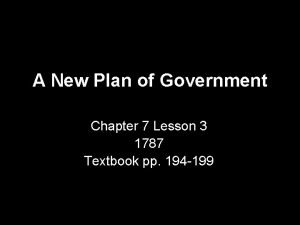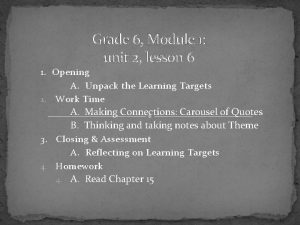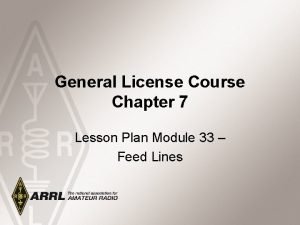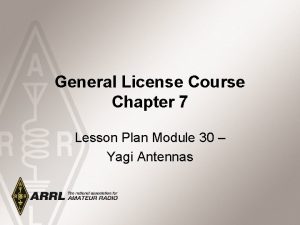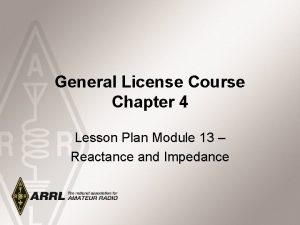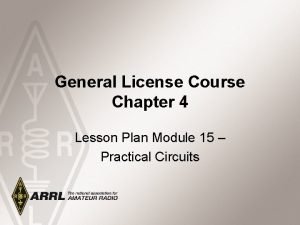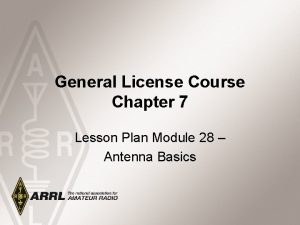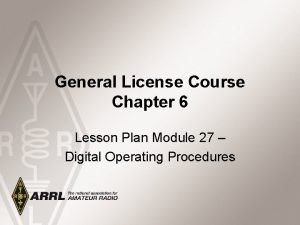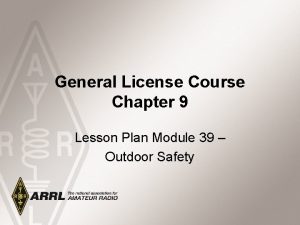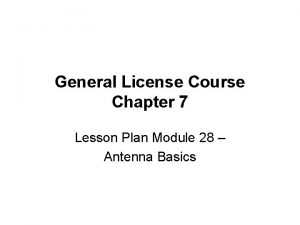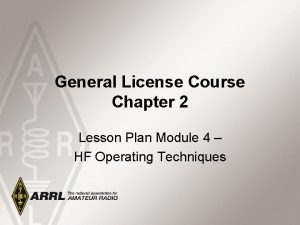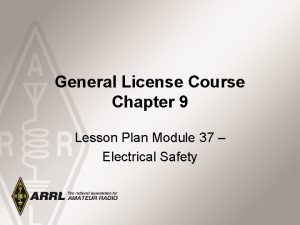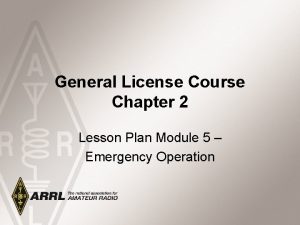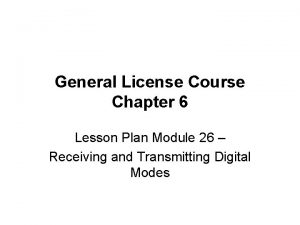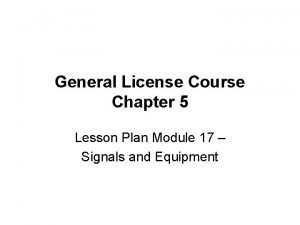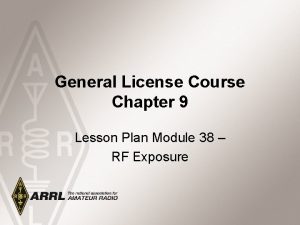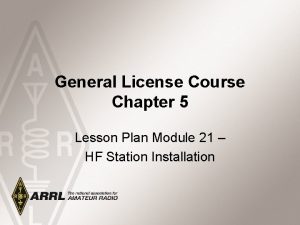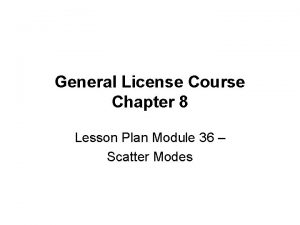General License Course Chapter 6 Lesson Plan Module



















- Slides: 19

General License Course Chapter 6 Lesson Plan Module 24 – Character-based Modes

Radioteletype (RTTY) • RTTY uses the Baudot code, which represents (encodes) each text character as a sequence of 5 bits • An initial bit (the start bit) and an intercharacter pause (the stop bit) are used to synchronize the transmitting and receiving stations 2015 General License Course 2

RTTY • Baudot code uses 5 bits for encoding data (32 different characters) • Not enough for the entire English alphabet, numerals, and punctuation • Two special codes, LTRS and FIGS, are used to switch between two sets of characters, increasing the number of available characters to 62 2015 General License Course 3

RTTY • On HF, the most common speeds are 60, 75, and 100 WPM (corresponding to 45, 56, and 75 baud) • Most RTTY conversations on HF are conducted at 45 baud and the most common shift between the mark and space frequencies is 170 Hz • You must match your speed and shift to communicate with the other RTTY station 2015 General License Course 4

Multiple Frequency Shift Keying • MFSK 16 uses 16 separate tones, all 15. 625 Hz apart • Withstands fading and distortion better than FSK • Domino. EX and Olivia are variations of MFSK • MT 63, “MT” stands for “multi-tone” data signal composed of 64 tones • Uses advanced DSP techniques which enable it to perform well under noisy and fading conditions 2015 General License Course 5

PSK 31 • The “ 31” stands for the symbol rate of the protocol, actually 31. 25 baud • PSK uses a variable length code called Varicode that assigns shorter codes to common characters and longer codes for others • Capital letters and punctuation characters take more bits and thus slow the contact 2015 General License Course 6

Practice Questions 2015 General License Course

What is the most common frequency shift for RTTY emissions in the amateur HF bands? A. 85 Hz B. 170 Hz C. 425 Hz D. 850 Hz G 2 E 06 2015 General License Course

What is the most common frequency shift for RTTY emissions in the amateur HF bands? A. 85 Hz B. 170 Hz C. 425 Hz D. 850 Hz G 2 E 06 2015 General License Course

How many data bits are sent in a single PSK 31 character? A. The number varies B. 5 C. 7 D. 8 G 8 C 02 2015 General License Course

How many data bits are sent in a single PSK 31 character? A. The number varies B. 5 C. 7 D. 8 G 8 C 02 2015 General License Course

Which of the following describes Baudot code? A. A 7 -bit code with start, stop and parity bits B. A code using error detection and correction C. A 5 -bit code with additional start and stop bits D. A code using SELCAL and LISTEN G 8 C 04 2015 General License Course

Which of the following describes Baudot code? A. A 7 -bit code with start, stop and parity bits B. A code using error detection and correction C. A 5 -bit code with additional start and stop bits D. A code using SELCAL and LISTEN G 8 C 04 2015 General License Course

Which of the following statements is true about PSK 31? A. Upper case letters make the signal stronger B. Upper case letters use longer Varicode signals and thus slow down transmission C. Varicode Error Correction is used to ensure accurate message reception D. Higher power is needed as compared to RTTY for similar error rates G 8 C 08 2015 General License Course

Which of the following statements is true about PSK 31? A. Upper case letters make the signal stronger B. Upper case letters use longer Varicode signals and thus slow down transmission C. Varicode Error Correction is used to ensure accurate message reception D. Higher power is needed as compared to RTTY for similar error rates G 8 C 08 2015 General License Course

What does the number 31 represent in “PSK 31”? A. The approximate transmitted symbol rate B. The version of the PSK protocol C. The year in which PSK 31 was invented D. The number of characters that can be represented by PSK 31 G 8 C 09 2015 General License Course

What does the number 31 represent in "PSK 31"? A. The approximate transmitted symbol rate B. The version of the PSK protocol C. The year in which PSK 31 was invented D. The number of characters that can be represented by PSK 31 G 8 C 09 2015 General License Course

Which type of code is used for sending characters in a PSK 31 signal? A. Varicode B. Viterbi C. Volumetric D. Binary G 8 C 12 2015 General License Course

Which type of code is used for sending characters in a PSK 31 signal? A. Varicode B. Viterbi C. Volumetric D. Binary G 8 C 12 2015 General License Course
 Macro lesson plan
Macro lesson plan Evs objectives
Evs objectives C device module module 1
C device module module 1 Hse culture ladder
Hse culture ladder Course module sample
Course module sample What i learnt from a gift of chappals
What i learnt from a gift of chappals Stretcher bond t junction
Stretcher bond t junction Course title and course number
Course title and course number Chaine parallèle muscle
Chaine parallèle muscle Adjutant general captains career course
Adjutant general captains career course Altering a driver's license may result in
Altering a driver's license may result in Chapter 1 the new jersey driver license system answers
Chapter 1 the new jersey driver license system answers Chapter 1 the new jersey driver license system answers
Chapter 1 the new jersey driver license system answers Overall state of well being or total health
Overall state of well being or total health Lesson 3 a new plan of government answer key
Lesson 3 a new plan of government answer key Planos en cinematografia
Planos en cinematografia Where did general lee surrender to general grant?
Where did general lee surrender to general grant? The great depression lesson 2 hardship and suffering
The great depression lesson 2 hardship and suffering Module 5 lesson 5
Module 5 lesson 5 Eureka math grade 6 module 1 lesson 6 answer key
Eureka math grade 6 module 1 lesson 6 answer key




